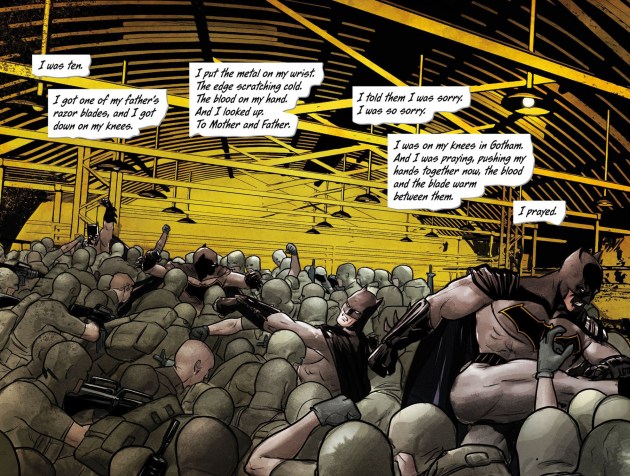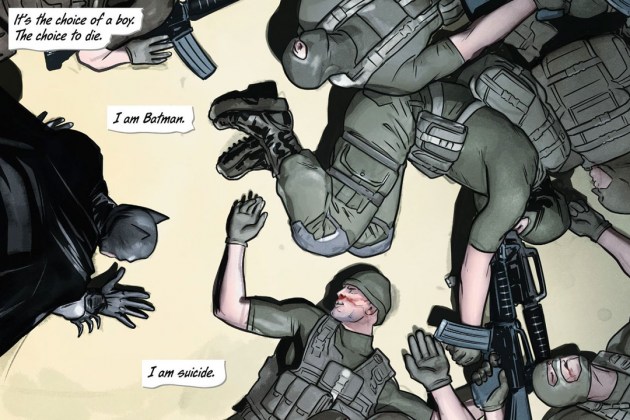Spoilers from last week’s Batman #12 ahead!
If you have read Batman #12 this past week, writer Tom King updates the Batman origin story in a subtle, but controversial way. While beating on Bane’s henchmen, Batman reveals that soon after his parent’s death, he began cutting, possibly with the intent of committing suicide. When he began to cut, he realized that to help Gotham, he must effectively “kill” Bruce Wayne, so that the mission of Batman can live on.

The idea of “Bruce Wayne being the mask and Batman being the real identity” is not a new idea. 2005’s Batman Begins succinctly shows how even though Bruce Wayne is literally back, once he trained and dedicated his whole being to the mission of Batman, the Bruce Wayne from previous years ceased to exist. As Katie Holmes’ character Rachel Dawes says:
“[Bruce Wayne] is your mask. Your real face is the one that criminals now fear. The man I loved, the man who vanished, he never came back at all. But maybe he is still out there somewhere. Maybe someday, when Gotham no longer needs Batman, I’ll see him again.”
What sets this apart from King’s interpretation is the implication that there is no hope of the “real” Bruce Wayne ever coming back. As a child, Wayne commits psychological and emotional suicide once he decided to make the vow to rid the city of crime. As a ten year old, he made the choice to “kill” Bruce Wayne and never look back. While that metaphor has been implied in past interpretations, King literalizes it with young Wayne attempting suicide. Initially, the story arc’s title “I Am Suicide” was referencing Batman’s personal Suicide Squad, but is actually referring to Batman’s feelings of death of his personal life as Bruce Wayne.
“It’s a choice of a boy. The choice to die. I am Batman. I am suicide.”

The most obvious implication is that on top of the surmounting tragedy of his parents’ deaths, Batman is now canonized a suicide survivor as well. So is this a good or bad thing? Does this taint the character as a cutter forever?
There is an uplifting message that as a suicide survivor who had feelings of depression and loneliness, Batman found a way to rise above his pain to do something productive with his life. In fact, not only did he rise above it, he uses his pain as a motivation to save thousands of lives.
However, Batman claims that he is already dead and his life since then has been nothing but borrowed time. That is a very bleak assessment of his life. Being Batman is not something to strive for, it is a self-imposed death sentence. It makes Batman fearless because he stopped caring for his life. It is not a very heroic, just makes him careless and nihilistic.
Both interpretations of Batman’s suicide attempt are certainly different, but equally valid ways of looking at it. However, since Batman #12 has hit the stands, King has done multiple interviews likening the “death” of Bruce Wayne is more an admission to a higher calling to be Batman. King from an interview with CBR.com:
“He decided, on almost an existential level, that he can’t live his life for himself anymore. It’s like he said, ‘I don’t see a point to myself anymore, but I can live my life for others.’ He says that the ‘selfish’ part of him is going to go away, the selfish part of him is going to die.”
While the wrist cutting is shocking and visceral, the underlying message is that Batman is not trying to condemn himself a slow death of constantly encountering dangerous threats. He is sacrificing his life for a greater good, similar to how a Catholic priest or the pope gives up his personal needs and wants to serve a higher mission. In this sense, Batman is still an inspirational figure, because he is not selfishly taking his anger and frustration out on criminals, he is making a purposeful choice to give up his life to save others. He is still the hero that we need and deserve.